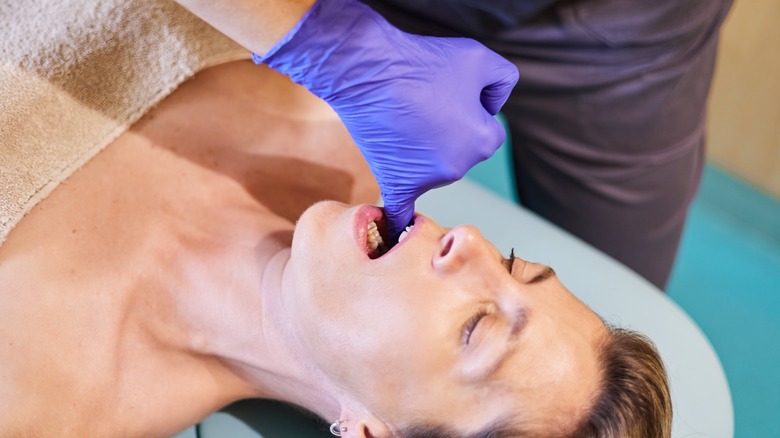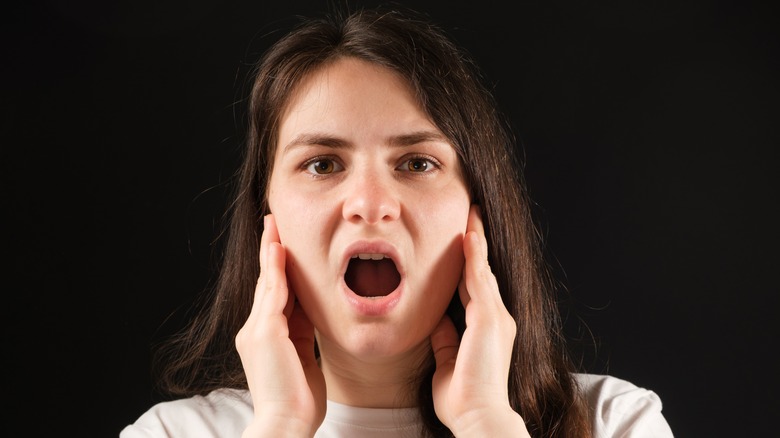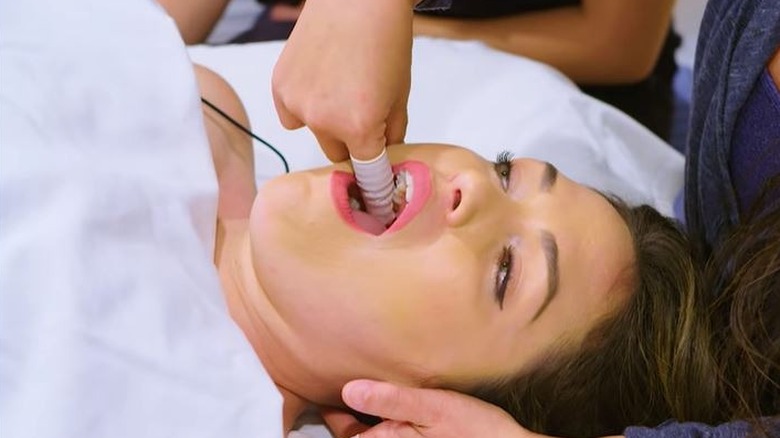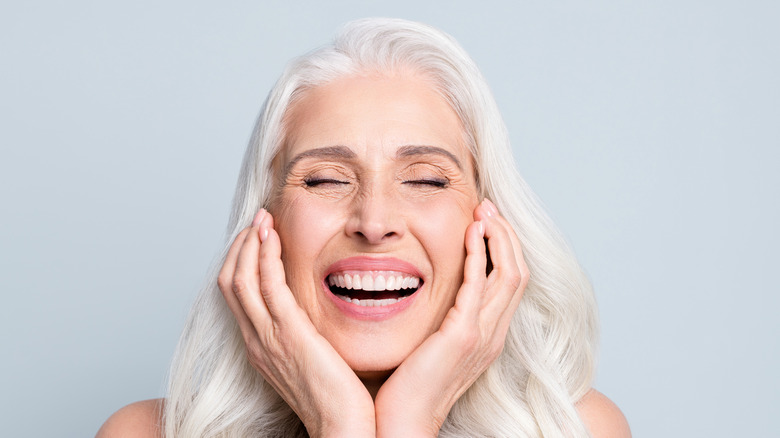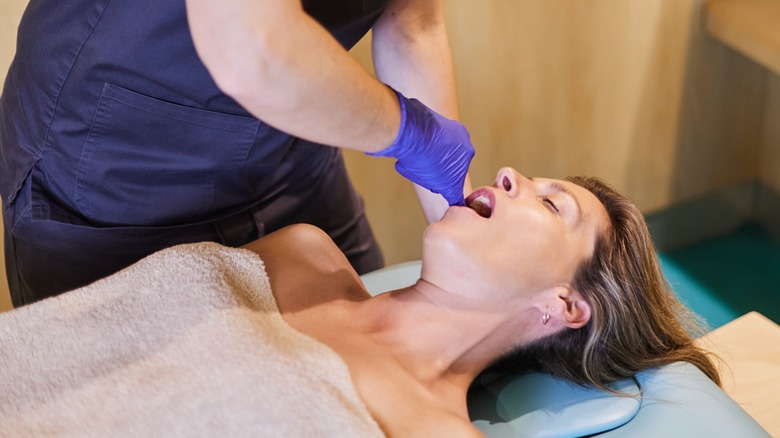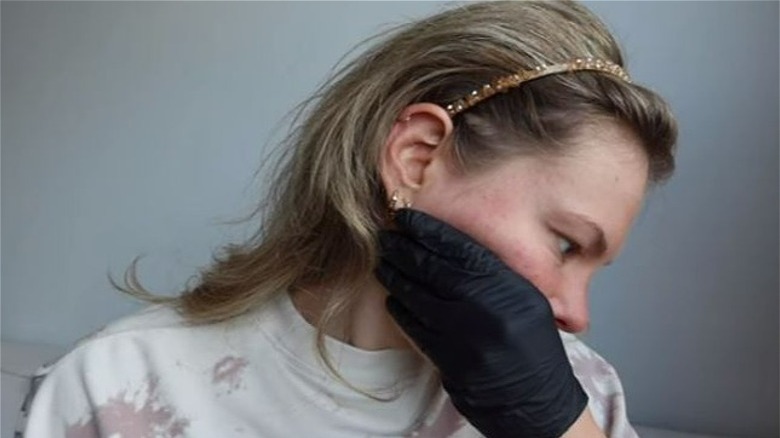Intraoral Massages Could Be Key In Easing TMJ Pain
Dealing with temporomandibular joint (TMJ) pain can be frustrating. In some cases, it's accompanied by facial discomfort, headaches, and a jaw-popping or clicking sensation, to name a few symptoms. MedicalNewsToday claims about 12% of Americans will experience a TMJ disorder at some point in their lifetime. The good news is, there are many ways to relieve the pain and discomfort.
TMJ disorder treatment options range from medication to splints to surgery. If you prefer a more natural treatment method, an intraoral facial massage — also known as a buccal facial — might be a good option for you. This technique may provide some much-needed relief without the need for a prescription or anesthesia.
An intraoral massage is just what it sounds like, a procedure that involves massaging the inside (intra) of the mouth (oral). With the right massage therapist, you can even experience relief from your TMJ disorder pain after a single office visit.
How an intraoral massage provides TMJ pain relief
To fully understand how an intraoral massage helps relieve TMJ pain, it's important to first recognize what a TMJ disorder consists of and what the symptoms are. The exact source of TMJ disorders remains unclear, according to the National Institute of Dental and Craniofacial Research, but research suggests that stress and genetics may be possible causes.
A TMJ disorder is a condition characterized by jaw pain or tenderness and/or jaw tightness that prevents the mouth from opening widely. Other symptoms sometimes include a popping sensation when opening the mouth, ear pain, headaches, dizziness, face or neck pain, ringing in the ears, and even hearing loss.
An intraoral massage aims to help loosen the tension of various orofacial muscles by creating friction. This friction increases the temperature of the soft tissues in the mouth, as ManchesterPhysio explains. As a result, blood circulation increases, which eventually leads to a comforting tension release.
What does an intraoral massage consist of?
Getting an intraoral massage resembles a visit to the dentist, but without the insertion of dental tools in your mouth. Serenity Spa & Natural Health Clinic provides a YouTube demonstration. While you're lying back in a chair, a massage therapist will insert their latex-gloved fingers into your mouth to slowly massage the orofacial muscles. This process involves applying pressure in various parts of the mouth, similar to a back massage.
The technique typically begins with releasing fascia around the lips and the front of the mouth. Fascia is a connective tissue supporting various muscles and other body parts (via Cleveland Clinic). This tissue should be flexible, but in some cases, it may be tight, which can lead to discomfort and pain.
Another aspect of an intraoral massage involves breaking up the masseter muscle, or jaw muscle, which is the one used for chewing (via Healthline). The masseter is the strongest muscle in the body based on its weight, according to The Library of Congress, but just like every other muscle, it can become tight and sore.
What to expect after an intraoral massage
As with any other treatment method, results vary from person to person, but some people experience immediate results after an intraoral massage. Jennifer Li, a beauty editor and intraoral massage recipient, shared her experience on The Zoe Report. Li received the massage from a holistic facialist as part of an external facial massage, after mentioning her TMJ discomfort.
After the intraoral massage, Li said her mouth "felt a lot looser and relaxed." Before the massage, she dealt with several TMJ disorder symptoms. "My main symptoms are getting my jaw stuck and struggling to open my mouth in the mornings," she said. She also noticed a clicking sound when opening her mouth before the massage, but afterward, she said, "... there was almost no click at all."
In addition to the physical relief that an intraoral massage can provide, some individuals also experience emotional release. Emma Simpson, a board-certified structural integrator, claims that some cry, laugh, or do both after a massage (via Inner West Bodyworks).
Therapists, including Li's, typically offer the option of a follow-up visit to reassess the jaw and determine if another session is needed. Li said the relief she received after her massage lasted at least three weeks.
How long does an intraoral massage take, and how much does it cost?
Jennifer Li claimed in The Zoe Report that her intraoral massage took 15 minutes, but that might have been because she received various other time-consuming treatments as well during her visit. Finding Balance, a therapeutic and clinical massage parlor, says that a standard first-time intraoral massage session should last about an hour.
The cost of an intraoral massage varies widely from practice to practice, depending on the length of the session and additional factors. Some clinics, like Spring Lake Massage Therapy & Wellness Center in Washington, charge $100 for a 60-minute session that includes an assessment and the massage. The clinic also offers a 45-minute session for $79. Evergreen Massage Therapy, also in Washington, prices a 30-minute session for $50.
Other practices, like Bodies in Balance Massage Therapy in Arizona, offer intraoral massages for just $10 as an add-on service to any session. Li received her intraoral massage as an add-on at Note to Self Wellness in Pennsylvania. Although intraoral massage was not listed on the website at the time of this article, Li asserted in her review that a sculptural facelift and intraoral service alone cost $300.
Can you give yourself an intraoral massage?
Although visiting a licensed therapist for an intraoral massage can be a great option for TMJ pain relief, you don't have to leave your home every time you seek this type of massage. You can give yourself an intraoral massage from the comfort of your living room, bedroom, or anywhere you'd like.
Mike Hamm, a licensed massage therapist and manual therapist, shared an instructional video on intraoral self-massage on his YouTube channel. The methods he provides are the same ones he offers to his patients, designed to allow them to massage their own jaws when they experience TMJ pain at home. However, he adds a disclaimer that you should consult a doctor for TMJ pain before attempting to perform an intraoral self-massage.
Freedom Physical Therapy Services also posted an instructional video on Facebook for the intraoral self-massage, specifically to target the masseter muscle. He demonstrates how to find the coronoid process — the ridge located in the back of the mouth — which Hamm mentions in his video as well. He also shows how to apply pressure using your thumb on the inside of your mouth and fingers on the outside.
An intraoral massage can release tension in the jaw, delivering much-needed relief from TMJ disorder pain. However, to reiterate Hamm's disclaimer, you should see a doctor first before performing an intraoral self-massage.
